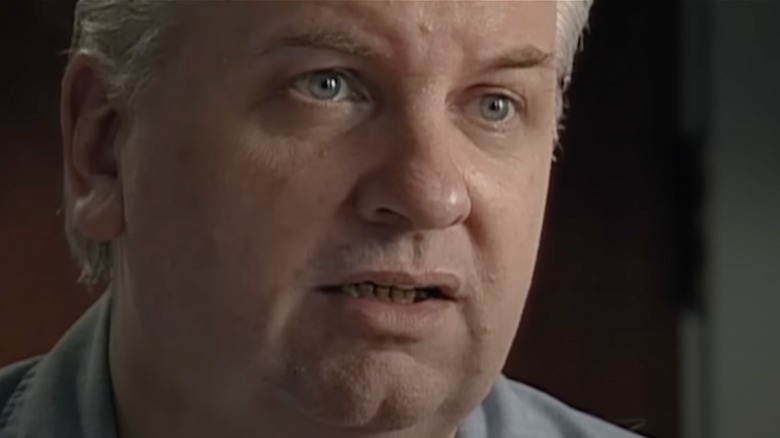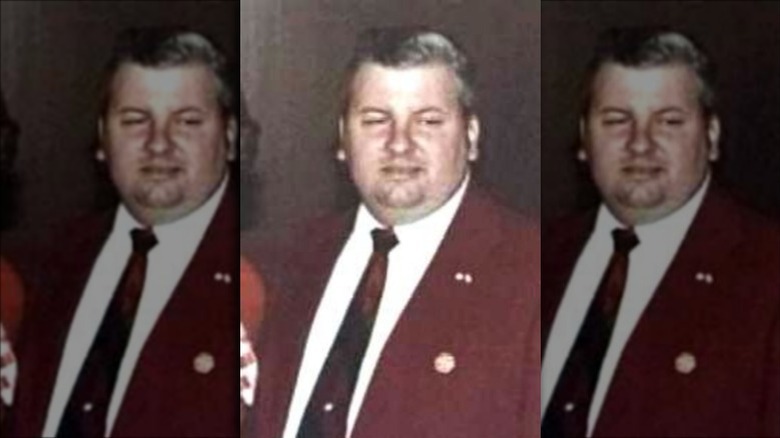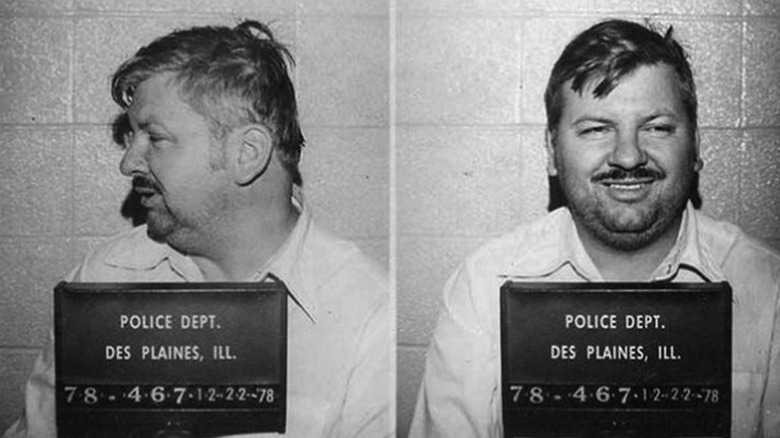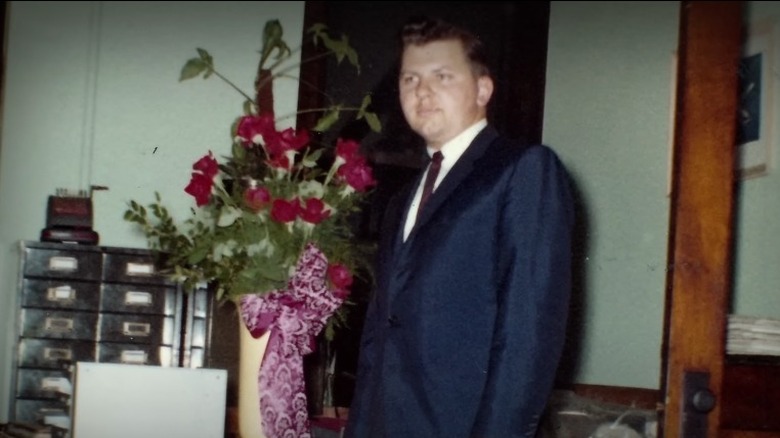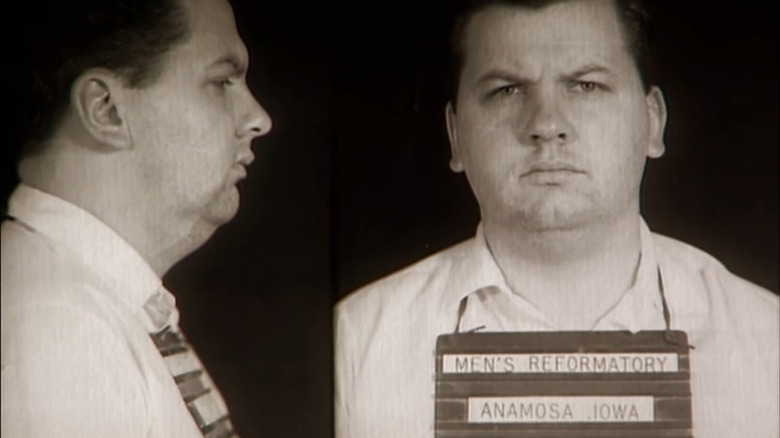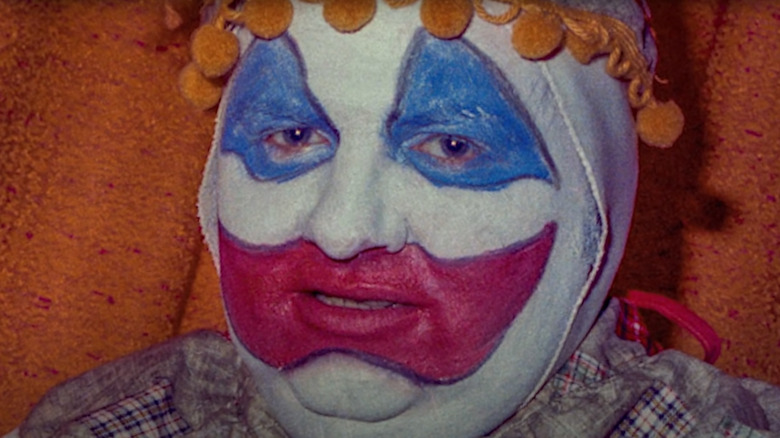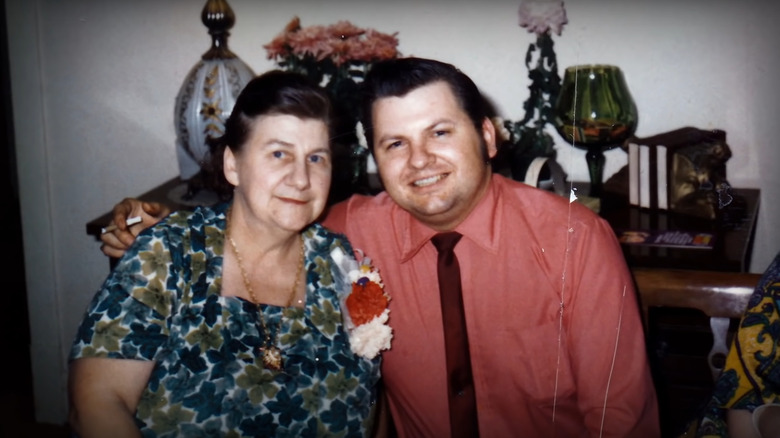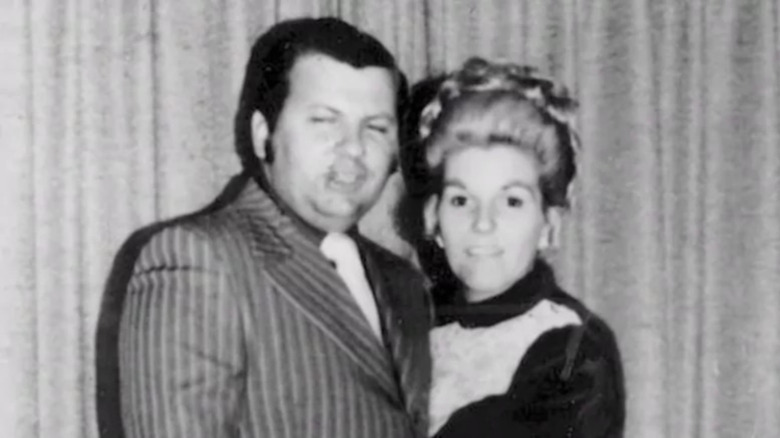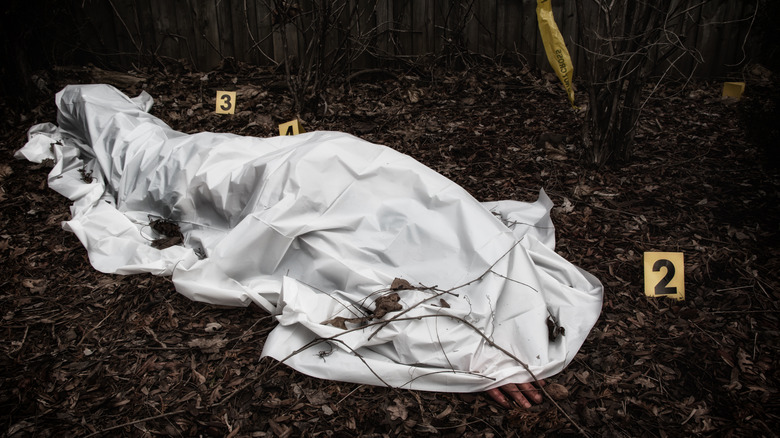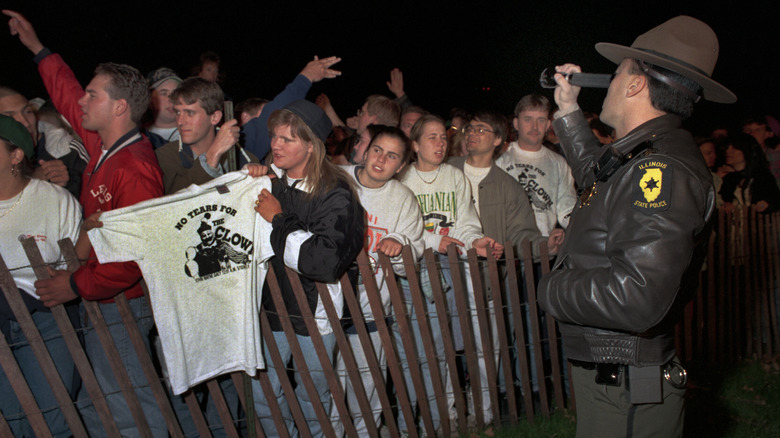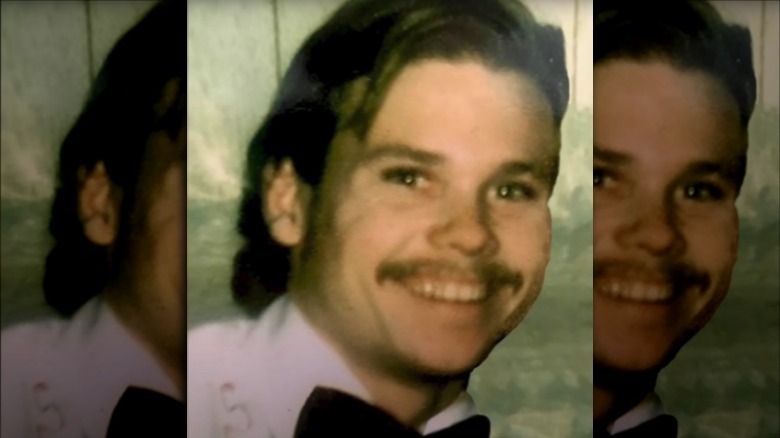The Timeline Of Serial Killer John Wayne Gacy's Life And Death
If you're ever feeling bullish about the overall goodness of humanity, just read up on John Wayne Gacy and you'll be cured. Gacy combined just about every evil you could possibly think of into one unattractive package: sexual assault, murder, and clowns.
He's known to have killed at least 33 people, and what's really amazing about Gacy's story is how long he was able to operate as an absolutely horrifying serial killer without being stopped. Gacy didn't fit the typical serial killer profile of an isolated, maladjusted loner. He was married twice, had children, and was a popular member of his community — all while tormenting his underage employees and murdering people. He was also a disturbingly cheerful and garrulous serial killer whose smiling pose in his mug shot after his arrest conveys a complete lack of humanity.
It's the flagrant nature of Gacy's behavior that amazes. He chose his victims from members of his own community and made only the smallest effort to conceal his crimes. Law enforcement knew he was a violent offender years before the true scale of his crimes was known, yet he continued to be a popular, social man right up to his arrest. Figuring out exactly how Gacy got away with it for so long requires an understanding of the sequence of events. To that end, here's a timeline of serial killer John Wayne Gacy's life and death.
March 17, 1942: John Wayne Gacy is born
According to Biography, John Wayne Gacy was born on March 17, 1942 in Chicago. His childhood was an unhappy one — he was born with a congenital heart condition that prevented him from playing with other kids in his neighborhood or at school, which made him into an outcast. According to "Killer Clown," Gacy's father was an angry alcoholic who would verbally abuse him, calling him a "mama's boy" or a "sissy," and frequently beating him with a leather strap. His father considered Gacy's heart ailment to be a sign of weakness, and despised him for it.
Gacy exhibited aberrant behavior from an early age. "Buried Dreams" reports that in 1949, when Gacy was just 7 years old, he was found with a neighbor boy and the boy's little sister. All three were naked, and the boys were reportedly "messing" with the girl. The incident enraged Gacy's father, who once again beat him.
According to the same source, that same year Gacy began riding along with a friend of the family who worked as a contractor. Gacy had shown interest in building, and his father's friend was happy to take him along. However, the friend molested the young boy, cajoling him into "wrestling" that always turned into something much more sinister. Gacy never told his father about these incidents, fearing his reaction.
1962: Gacy tries to leave home
John Wayne Gacy's home life was miserable, and it did not improve as he got older. According to the New Yorker, when Gacy was 19, his father helped him to purchase a car, but required Gacy to pay back the loan. When Gacy fell behind on the payments, his father threatened to take the car keys away. Out of work and unhappy, Gacy finally decided to leave — he packed up his belongings and one day simply drove away, heading west.
According to "Killer Clown," Gacy stayed in Las Vegas for several months and took a job working as a mortuary assistant. His boss, George Wieckowski, remembered Gacy as a pleasant, polite young man. Cosmopolitan reports that Gacy was allowed to sleep on a cot behind the embalming room at the mortuary because he had no money to secure an apartment. The same source claims that one night he became aroused at the sight of the body of a young boy, and climbed into the coffin with him. The incident alarmed him so much he immediately returned home to Illinois.
Gacy then took a job at a shoe company and joined a local civics organization called the Junior Chamber (aka the Jaycees). Gacy seemed to settle down to become a respectable member of his community.
1964: Gacy marries and launches a career
According to Cosmopolitan, while working at the shoe factory in Illinois, Gacy met his first wife, Marlynn. The New Yorker reports the couple married in 1964 — just before Gacy had a strange sexual experience. After a night of drinking, Gacy passed out at a friend's house, and awoke to find the man sexually assaulting him. Gacy chose not to stop the activity, and was tormented by the fact that he'd enjoyed it.
Slate notes that Gacy and Marlynn then moved to Waterloo, Iowa in 1966, where Gacy's father-in-law hired him to manage three Kentucky Fried Chicken franchises. According to "Killer Clown," his father-in-law didn't like Gacy, but gave him a large salary and bonus in order to ensure his daughter's happiness. "Buried Dreams" reports that Marlynn and Gacy had a son in 1966 and a daughter in 1967.
Between his activities with the Jaycees, his new family, and his new business acumen, Gacy quickly became an established member of the community. He capitalized on his position by creating a "club" in his basement, where he brought his teenage employees for parties at which they drank alcohol and watched pornography. "Killer Clown" also notes that Gacy became involved with a group of fellow Jaycees who frequently gathered to gamble, engage sex workers, watch pornography, and even swap wives.
1967: Gacy commits sexual assault
According to the New Yorker, in 1968 John Wayne Gacy was arrested for the first time. Two teenage boys who had worked for Gacy accused him of sexual assaults stretching back to the previous year. One night, Gacy had offered a boy who worked at one of his Kentucky Fried Chicken locations a ride home, but took him to his own house instead — Gacy's wife was in the hospital at the time, in labor with their daughter. Gacy plied the boy with alcohol, showed him pornography, and then choked him until he passed out. He then drove him home and fired him from his job the next day. Another boy reported that Gacy had convinced him to perform sexual acts after showing him pornography.
Charges soon followed, and Gacy demanded to take a polygraph test, which he failed. According to "Killer Clown," Gacy hired another teenager, Russell Schroeder, to intimidate one of his accusers. Schroeder convinced the boy to drive out to a remote location with him. There, he sprayed mace in the boy's eyes and beat him up, eventually attempting to hold his head under water. The boy struggled free and fled. Esquire reports that in May, 1968, Gacy was convicted of sodomy and sentenced to 10 years in prison. He only served 18 months, and was paroled in 1970.
1968: A diagnosis of antisocial personality disorder
After two teenagers came forward to accuse Gacy of sexual assault in 1967, Gacy was charged and arrested. "Killer Clown" explains that Gacy was ordered to undergo a psychiatric evaluation, and was sent to the Iowa Psychopathic Hospital. There, his behavior was unstable — he was friendly and helpful, but also boasted of his wealth and power, cried frequently, and became hostile if his version of events was challenged in any way.
The doctors who examined Gacy concluded that he exhibited antisocial personality disorder (APD), a condition in which the individual is "unsocialized" and thus behaves in ways that bring them into conflict with society's rules. As noted by Stanford Magazine, APD is often considered a euphemism for psychopathy. Gacy was never found to be insane. Rather, he was considered to be fit to stand trial, because he knew that his actions were illegal and never claimed to be under the control or influence of any other entity. But he was clearly a man who committed crimes simply because he enjoyed them, not out of any rational motivation such as revenge or anger.
At his trial, Gacy admitted he'd had sex with the boys but described it as a consensual act that he'd engaged in experimentally. Despite the diagnosis and an official recommendation that he be given probation, the judge in his case sentenced him to 10 years imprisonment.
1969: Gacy's wife divorces him
After his diagnosis of antisocial personality disorder and his conviction on charges of sodomy (per "Killer Clown"), John Wayne Gacy's wife of three years, Marlynn, filed for divorce (via Esquire). Gacy reportedly angrily refused to cooperate, but the New York Times reports that Marlynn was granted a divorce on September 18, 1969 on the grounds of cruel and inhuman treatment. She was also granted full custody of their children. However, Marlynn claimed that she was shocked at the revelation of Gacy's behavior and said that she had never been afraid of him. She described him as a good father, and expressed disbelief that he might be homosexual. She moved away and remarried, and later in life agreed to interviews only if her new name was kept out of the press.
According to "Killer Clown," the last time Gacy saw Marlynn was at a hearing in 1969, prior to the divorce decree. He apparently made no effort to reconnect with his wife and children after his release, and in fact never saw his children again and began telling people that they were dead.
1972: Gacy marries for the second time
According to Esquire, John Wayne Gacy served 18 months in prison after being charged with sodomy, and was released from prison in 1970. Amazingly, he was able to effortlessly rebuild his life after his release. He moved to Chicago, purchased a house, and launched a construction business. He became involved in local politics and was instantly popular in his new neighborhood, where he threw frequent parties. He also got married for the second time, to a woman named Carol Hoff.
The New Yorker reports that Hoff and Gacy knew each other in high school and had even gone on a date. After Hoff's divorce in 1971 she began spending time with Gacy again. Gacy admitted his legal problems to her, and even told Hoff that he was bisexual, but Hoff didn't believe him. Gacy got along well with Hoff's two daughters, and the couple married in July of 1972 — nine days after Gacy had been arrested for assaulting a young boy and then trying to run him over with his car. The charges were dropped, and it's unclear if Hoff knew about them.
However, the marriage didn't last. Oxygen reports that Hoff began suspecting Gacy of being unfaithful. She found photos of naked men and wallets belonging to teenage boys around the house and in Gacy's car. Despite her findings, Hoff continued to be in denial regarding her husband's sexuality — when she filed for divorce in 1976, her grounds were his infidelity with other women.
1972-1978: A serial killer in full
After serving time in prison on charges of sodomy, John Wayne Gacy moved to Chicago and started a construction business — and ramped up his criminal activities. Gacy became a popular figure in his community, throwing parties and often dressing as Pogo the Clown for local events. But he was edging closer and closer to the horrific violence that has become his legacy.
Esquire reports that in 1971, Gacy picked up a boy at a bus station and attempted to sexually assault him. Gacy was arrested, but when the boy failed to appear in court the charges were dismissed. According to Biography, in January 1972, Gacy drove to the bus station again and picked up a young boy named Timothy McCoy. He gave McCoy alcohol and had sex with him, then stabbed him multiple times, committing his first known act of murder. Gacy buried McCoy in the crawl space under his house.
The Chicago Tribune reports that Gacy murdered his second victim, who has never been identified, in 1974. Then, as if a switch had been flicked, Gacy began a horrifying killing spree, murdering at least 31 more young boys and men between July 1975 and December 1978. According to the New Yorker, he continued to bury their bodies in the crawl space. His wife, Carol, noticed a horrible smell, but Gacy claimed it was due to a broken sewer pipe.
Dec. 21, 1978: Police execute a search warrant
According to Biography, police began to suspect something was going on with John Wayne Gacy as early as January, 1976. Esquire reports that local police investigated Gacy in connection with the disappearance of two young boys who had worked for his construction company, but never filed charges. When a 9-year-old boy described as a child prostitute went missing in early 1976, the police staked out Gacy's house. They questioned several young men who had come and gone from the house, but learn nothing.
Amazingly, the red flags continued to pop up. The Chicago Tribune reports that in March 1977, Gacy was accused of luring a man named Jeff Rignall to his home, knocking him unconscious and handcuffing him before sexually assaulting him — but the case was settled in civil court while Gacy was only charged with misdemeanor battery. In December Gacy was arrested for kidnapping and assaulting a teenage boy, but the prosecutor declined to pursue the case.
Finally, in December 1978, a high school student named Robert Priest vanished after finishing his shift at a local pharmacy in Des Plaines, Illinois. Priest told his mother he was meeting with a man about a construction job before he disappeared. Gacy was soon identified as the man Priest went to meet, and within a week police arrested Gacy and discovered the remains of his victims in the crawl space of his home.
March 1980: Gacy convicted
After a lifetime of committing violent crimes, John Wayne Gacy took remarkably little time to confess once arrested. According to the Chicago Tribune, after just one day in custody Gacy admitted to murdering 32 boys and young men after having sex or sexually assaulting them. Bizarrely, he referred to himself in the third person in his confession, and helpfully drew maps and diagrams showing the locations of his victims' bodies. However, as the New Yorker notes, the prosecutor opted not to record the confession, and Gacy later denied he'd ever offered it.
As reported by Esquire, Gacy's trial on 33 charges of murder began on February 6, 1980. According to Britannica, his defense team attempted an insanity defense, offering testimony from several doctors that he was a schizophrenic. The trial lasted five weeks, but in the end the jury needed just two hours to convict Gacy of all 33 counts of murder. On March 13, 1980 John Wayne Gacy was sentenced to the death penalty for his crimes. He would spend the next 14 years on death row, working through a series of appeals and writing at least two books insisting that he was an innocent man and describing himself as "the 34th victim."
May 10, 1994: Gacy executed
John Wayne Gacy worked actively to overturn his conviction and death sentence. As noted by Biography, he took his case all the way to the Supreme Court in 1985, arguing that his death sentence was "cruel and unusual punishment." The court rejected the argument overall, but a dissent written by Justice Thurgood Marshall asserted that Gacy's argument did have some consitutional merit, and this opinion allowed Gacy's appeals to continue for nearly a decade. He attempted to bring another suit to the Supreme Court in 1993, but the court declined to take the case. Gacy's execution was finally scheduled for May 10, 1994.
The Los Angeles Times details Gacy's final night: a final meal of french fries, fried shrimp and chicken, and fresh strawberries. Gacy was reportedly very cooperative and calm. While he was being strapped into the gurney in preparation for receiving a lethal injection, he told officials that his death wouldn't "compensate for the loss all the other lives," but made no attempt to stop the execution. AP News notes that his execution was witnessed by 23 relatives of his victims. The officials had to stop the procedure when they experienced a malfunction, but after the problem was rectified Gacy was given a sedative and appeared to fall asleep. He was then given a synthetic form of the poison curare, and at 12:58 am he was pronounced dead.
Oct. 12, 2011: Renewed effort to name Gacy's victims
John Wayne Gacy's conviction in 1980 and execution in 1994 seemed to mark the end of his grisly story. But one aspect of Gacy's horrifying existence has remained a sore point for many: the eight victims who remained unidentified.
According to Esquire, in 2011 Cook County Sheriff's Department announced a fresh effort to identify these young men using modern genetic testing technology. Biography reports that the remains of the eight victims were exhumed, and relatives of young men reported missing in the 1970s were asked to come forward to provide DNA samples. CBS Chicago notes that the effort was an immediate success when Victim No. 19 was identified as William George Bundy, who went missing in October 1976. Six years later, CNN reports that James Byron Haakenson was identified as Victim No. 24., missing since August of 1976. And in October, 2021, the Washington Post reports that Victim No. 5 was identified as Francis Wayne Alexander (pictured). Alexander's family had never reported him as missing, assuming he had started a new life and wished to break off contact.
The work continues. Five of Gacy's victims remain unidentified to this day, and while advances in genetic testing offers hope, without samples and police reports to work with they may remain unknown forever.
